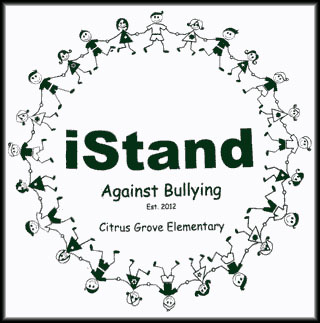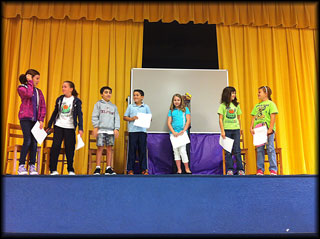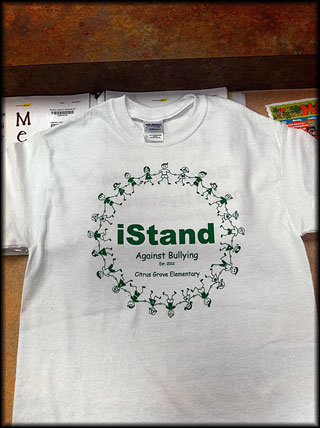“iStand” and Citrus Grove Elementary
In 2012, Shawna Hixon and Lana Barros from Citrus Grove Elementary in Palm City, Florida led an innovative program, “iSTAND”, which they designed to creatively engage students to take action against bullying. In an interview with Shawna, she provides information about the origin of the initiative, what it took to be successful, and the resources for starting an iSTANDER group at your school.
Shawna writes, “At the end of the 2011-2012 school year, while going over the SAC survey that students complete every year, I was alarmed at how many students were concerned with bullying incidents at our school. I thought that if it was a strong enough feeling for them to mention it on the survey, then it was worth looking into and investigating further. I had always thought of bullying being a problem in the middle and high schools. To my surprise, it was just as big of a problem at the elementary level. Unfortunately, at this level, children do not understand that it is not okay, it does not have to happen and there is somewhere to turn. I was then on a mission to bring the survey to the attention of our administrators in hopes to start a bully awareness club at our school.”
Shawna shared that in her research she discovered two elements that seemed critical for success. The first was about funding, like most schools, hers had minimal budget for new activities, so it needed to be something that required minimal resources and financial commitment. The second, was based on how to best engage students on the issue, her research showed that students were more likely listen to and follow peers rather than adults. With those two things in mind, she decided on an approach that was student oriented with strong, influential peers and hands on ideas made from scratch.
The next step was to secure permission from administration, and once she had the “go-ahead”, she approached Mrs. Lana Barros for her help and support. Together, they worked on a name for the group, ideas such “Bully Busters”, “Stomp Out Bullying”, were suggested, but none seemed to fit. They didn’t want students walking around like Ghostbusters, jumping in to try to solve issues on their own or anything that may look like we wanted students to take things into their own hands. Shawna said that, “as we were researching different ways to deal with bullying situations that were appropriate for students of our age levels, we noticed that a lot of scenarios encourage students to take a stand. To stand up for friends who may be getting bullied, to stand up to the bully if it’s their self who is the target and to take a stand to spread the word about bully awareness. As a result, “iStand” was born. During one of our first meetings, I was explaining to the kids what our mission would be, which is to promote bully awareness, so that students know others are watching and will take steps to interject instead of standing by and letting it happen. Their role would be to model positive behaviors, to encourage others to take a stand by using the tools we discuss during our meetings and to take a stand themselves if they see bullying either by standing up or getting help when needed. Then, voila, the phrase, “Be an iStander, not a bystander”, came out. It just fit and the students loved it.”
Now that the group had a name, they needed activities. Shawna, knowing that they were proceeding with a budget, went online, and this is where she found PACER’s National Bullying Prevention Center. On the site she found numerous resources to use with the club. She shared that, “they decided to declare a “Bully Awareness Week” and include activities such as a poster contest with the theme, “Be an iStander, not a bystander”, “iStand for……….” cards that the whole school filled out and we displayed in the atrium while spelling out “iStand” with them, an “I am different” chain piece to where each student wrote something on their piece that made them different, then we linked them all together to show that we can all be different but still respect each other and get along. On the last day we had a “Wear your favorite team” shirt to go along with the being different, but still being friends idea.”
The initial response from the students was overwhelming positive and that’s when they knew that “iSTAND” was going to make a difference.
When asked the keys to being successful with the initiative, Shawna said,
- The key to bully awareness is to keep the awareness visible.
- iStand does this by teaching the tools that students can use through skits portraying actual school incidents that the students encounter at various times of the day done by the iStand group.
- Examples would be the playground, the cafeteria, extended day, in the hallways, in the classroom, etc. We get this information by having student feedback discussions during our meetings. It’s at this time that we get to see bullying through the student’s eyes as well as how they feel it is being handled by teachers and/or administration at our school.
- We also keep awareness visible through posters students have made, showing the videos our iStand group makes on the morning school news, on stage skits during early release assemblies and varies activities we may come up with that involve the whole student body.
- Our school counselor, Mr. Scholl, has also started referencing our iStand group when talking to students about bullying and character counts, explaining to the classes what being an “iStander, not a bystander” represents.
Shawna also has plans for the future, which include:
- Share the iStand program with other schools. We have found that awareness through our students is the best way to get the message out there. Using the iStand group as tools through skits, videos and modeling behavior keeps the budget low and the interest from their peers high. We use online resources, such as the PACER site which has a lot of valuable tools, as well as others you can find on the internet. Using “iStand “ in elementary schools across the board would not only increase awareness at an early age, but also give school groups a chance to share ideas of what activities are working to bring and keep the awareness alive among the students and staff.
- Create a branch of “iStand” to incorporate it in the middle schools, using the campaign name, “Demonstrate Don’t Intimidate” slogan. In the elementary schools we use “Be an iStander, not a bystander”. While we can still use that in the middle schools, we also want to focus on those students with strong personalities to be an example and use that strength to demonstrate positive role modeling among their peers. At the elementary level, even though they happen, we try to keep all of the grim consequences of bullying out of the meetings and activities. At the middle school level we will go a little more into the desperate measures that students may take to escape the pain of and avoid bullying, both at school and through technology (internet, cell phone, etc.), in order to target the specifics of bullying at their age level.
Shawna has offered to share several of the resources from the toolkit that she and Lana developed, these free resources include:
“We can do so much with so little if it’s presented in the right ways. Just knowing someone is watching, listening and willing to stand up could mean the world to that one person who dreads going to school every day.” Shawna Hixon






